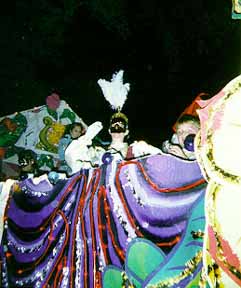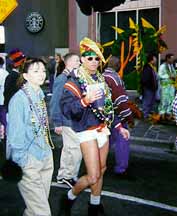
 Mardi Gras Marred by Social Stratification, Violence  By Love Rutledge
By Love Rutledge
When explorer Pierre le Moyne, Sieur d'Iberville, and his men named a spot on the west bank of the Mississippi "Point du Mardi Gras," in honor of France's festival, they had no idea what they were starting. Nearly 300 years later, a record 2 million people converged in New Orleans to participate in the revelry that ran from January 31 this year to Fat Tuesday, February 16. Hordes of young and old alike came to witness the world-famous displays of balls, booze, breasts and beads set to the tune of "Mardi Gras Mambo." But while the crowds partied like it was 1999, the glaring social stratification of the city became increasingly evident. While Carnival in Rio De Janeiro, Brazil is dubbed an inversion of traditional societal roles, America's version of the same festival, Mardi Gras, demonstrates the opposite: a clearer, more marked separation between male/female, black/white, rich/poor, which manifests itself in many ways. The all-female krewes, or Carnival organizations, like Isis and Iris, remain at the bottom of the list, known for their lack of finesse and good throws (if any plastic trinket can indeed be of high quality). Despite a city ordinance nearly eight years old forcing krewes to integrate, the absence of blacks from the festival remains conspicuous. Zulu, the 83-year-old African-American krewe, boasts prestige, but the only other blacks seen on the parade routes, barring spectators, are the flambeaux. Flambeaux are, as defined by Mardi Gras guru Arthur Hardy, "Naptha-fueled torches, traditionally carried by white-robed black men." The torches originally served as the only light-guiding parades down their routes. To pay these men for their services, crowd members toss change into the street for the flambeaux to pick up out of the trash and horse manure left by the animals carrying ornately-costumed riders. This could hardly be dubbed a distinguished role.  Obviously the elite of New Orleans, whose homes line St. Charles Avenue, are truly treated like royalty during the holiday. They make up the more illustrious krewes and are — literally — their royalty, presented at lavish balls held in venues like the Super Dome that accommodates thousands. Outsiders may buy tickets to watch the festivities, and if they are truly lucky, may be given invitations by members of the krewe to participate themselves.
Obviously the elite of New Orleans, whose homes line St. Charles Avenue, are truly treated like royalty during the holiday. They make up the more illustrious krewes and are — literally — their royalty, presented at lavish balls held in venues like the Super Dome that accommodates thousands. Outsiders may buy tickets to watch the festivities, and if they are truly lucky, may be given invitations by members of the krewe to participate themselves.
But not all of the Crescent City's wealthy hang around for the festival. It's common knowledge that ski resorts across the U.S. swell in February and March with the onslaught of upper-crust New Orleanians. Despite the division that Mardi Gras invokes, the utter grandeur and largesse, the total experience of Mardi Gras New Orleans-style overwhelms even the more experienced Carnival-goers. And those who participated in the party this year kept relatively safe, in contrast to those who journeyed to Mobile to celebrate. Alabama's port city witnessed three shootings on parade routes this year, prompting one local television station to remark on the high crime and death rates in Mobile during Mardi Gras. According to Mobile's Executive Director of Public Safety Richard Cashdollar, approximately 900,000 people watched the parades in that city roll, and in two separate shooting incidents on parade routes, one person was seriously injured and two were killed. This certainly taints the image of Mobile's Mardi Gras, known as a family-oriented celebration. "Given the nature of the large crowds, it's impossible to eliminate these kinds of incidents," he said. Evidently New Orleans has figured out how to do just that. "I don't ever recall a Mardi Gras- related death, not in my 18 years here on the force," said Lieutenant Marlon Defillo of the New Orleans Police Department. "For our large crowds, we have relatively little violence." Perhaps due to a difference in attitude, style or tradition, this trend marks an interesting split between these two cities with such a similar heritage. While the media provided commentary on Carnival, Carnival provided commentary on the political world. As one would expect, the most notable and frequently displayed pokes at our leaders were references to the Clinton/Lewinsky affair. The plastic cigar, a Mardi Gras staple, took on new meaning this year, making it an unusually popular item in the French Quarter, especially on Valentine's Day, which squarely fell into the 1999 Carnival calendar. Harry Connick, Jr., Sandra Bullock and K.C. and the Sunshine Band were among the celebrities that graced New Orleans' streets during the festivities. Another celeb, the king of Rex, also known as the king of Carnival, made his way through the city. The traditional Mardi Gras colors (green for faith, purple for justice and gold for power) were first displayed by the krewe of Rex in 1892. Though Mardi Gras in New Orleans may serve to alienate some, it is arguably the best party around, drawing millions from every corner of the world. 
[Love Rutledge is a free-lance writer working on a Bachelor's degree in Spanish and communications at Tulane University in New Orleans]. Back to Contents Copyright © The Southerner 1999. 

|
